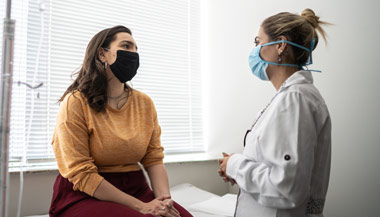Patient Story
Gastric Balloon for Weight Loss: Lisa’s Story

Patient Story Highlights
- In her 50s, Lisa was obese but ready to take control of her life and health.
- Lisa consulted with the Johns Hopkins Concierge Endoscopic Weight Loss Program and learned about the gastric balloon program.
- With the expertise and support of the weight loss team, Lisa changed her life, lost 80 pounds and gained improved health and wellness.
Lisa is a petite 50-something who stays fit and healthy with a plant-based diet, daily 5-mile walks and eight hours of sleep a night. It’s a dramatic departure from December 2016, when her body fat percentage was nearly 50 percent. Painful back problems made it difficult to get out of bed and left her hobbling, and she was getting an average of only four hours of sleep a night.
Having spent the last 18 years of her career helping women and children improve their lives, Lisa realized it was time for her to do the same for herself.
“The handwriting was on the wall, and it said, ‘Get help,’” says Lisa. “I was obese and in a debilitating state of health, so I chose to invest in myself.”
Committed to transforming her health, the Texas resident knew it would take a holistic approach to make changes in her thinking and eating to create a lifestyle that would last. Her research on the best way to make that transition led her to Johns Hopkins and the gastric balloon weight loss program offered through their concierge endoscopic weight loss clinic.
The year-long endoscopic gastric balloon program combines a nonsurgical procedure with coaching and support from a team of weight loss experts to help people lose weight and make lifestyle changes to keep the weight off.
The gastric balloon is a great tool, but without a commitment to change diet and lifestyle, patients won’t achieve lasting success. That’s why this program addresses both aspects of weight loss — losing the weight and keeping it off.
During the procedure, the doctor places a balloon in the patient’s stomach through the mouth using an endoscope—a thin, flexible tube with a tiny camera and light. The balloon is filled with saline and takes up space in the stomach so patients feel full faster and less hungry between meals. They learn to eat less and usually have rapid weight loss in the first four months of treatment. The balloon is removed after six months, but the team continues to work with patients by phone and email for another six months to help them maintain their new, healthier lifestyle.
A Nonsurgical Weight Loss Tool
According to the program’s experts, 114 million people in the United States would benefit from some type of weight loss regimen, and 16 million would qualify for bariatric (weight loss) surgery.
Obesity is a chronic disease that puts people at risk for developing conditions such as heart disease, high blood pressure, diabetes and osteoarthritis. The gastric balloon treatment is a safe weight loss treatment option for some patients who do not want to have surgery.
The procedure isn’t the best option for people who have a hiatal hernia, uncontrolled reflux, are on blood thinners or have had stomach surgery.
The Food and Drug Administration (FDA) approved the gastric balloon procedure for use in the United States in 2015. Johns Hopkins was one of the first hospitals to offer the procedure. Johns Hopkins physicians were among the first trained in the procedure before FDA approval, and now train other doctors.
Lisa Learns What It Will Take to Succeed

Lisa had a phone consultation with the team, including Margo Dunlap, R.N., a clinical registered nurse and the program coordinator. Together, they discussed Lisa’s medical history and reviewed her medical information from her primary care doctor to determine if she was a candidate for the program.
They also talked candidly with Lisa about the limitations of the device and the work that was ahead for her.
They stressed that, regardless of the weight loss therapy used, at the end of the day, it’s up to the patient. The gastric balloon is a great tool, but without a commitment to change diet and lifestyle, patients won’t achieve lasting success. That’s why this program addresses both aspects of weight loss — losing the weight and keeping it off.
Team Effort Sets Concierge Program Apart
Although Lisa’s success was ultimately up to her, the year-long treatment incorporates support from a medical internist, nutritionist, exercise physiologist and a behavioral psychologist to help her learn and stick to the right habits.
Lisa felt the program was the jumpstart she needed in her journey to becoming the “new me.” She also believed the team was the clear choice to help her get there. She valued their experience and reputation and their flexibility to work with her from a distance. The program is one of many at Johns Hopkins that treats patients living out of state and internationally.
In December 2016, Lisa traveled to Johns Hopkins for the 20-minute outpatient procedure, which requires only mild sedation. Back home in Texas, she launched her new lifestyle. Her daily regime included walking, drinking at least 64 ounces of water, juicing with fruits and leafy green vegetables, and sleeping eight hours a night.
“I jumped in feet first. I defined what healthy thinking, eating, resting and living should and would be in my life,” says Lisa. “The balloon system was the first step. I knew I would lose or gain weight based on what I was willing to put into the program.”
A Bright and Active Future

Dunlap says that, after the balloon is placed, she talks with patients daily until they’re comfortable, and then emails or calls twice a month. But she’s available to provide as much support as a patient wants and needs.
“Lisa was committed and did everything she could to hold herself accountable to make sure she was as successful as she could be,” says Dunlap. “She updated me every week about what she was eating and sent me videos every morning during her 5-mile walk.”
The steady contact and commitment paid off. By March, Lisa had dropped 35 pounds, and by the time the balloon was removed in June she was down another 25. When she emailed Dunlap while vacationing in Italy in September, she reported a total weight loss of 80 pounds and a body fat percentage just over 28 percent. Lisa has added resistance training to her exercise routine and continues to enjoy a mostly plant-based diet. She even bypassed Italy’s pasta and wine with no regrets.
The team attributes Lisa’s success to her focus on her goal and commitment to a lifestyle change.
Lisa says the program was an investment in herself.
“I had to do the work, but I had the right team in place to guide, support and encourage me. They were with me every step of the way as I reshaped my thoughts, body and life.”
Johns Hopkins Endoscopic Weight Loss Program
The team with the Endoscopic Weight Loss Program offers innovative weight loss procedures that do not require invasive surgery. We take a collaborative approach to obesity management that combines the expertise of many specialists, which helps us offer high-quality care and enable long-term weight loss.




